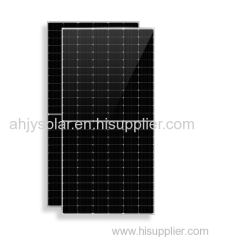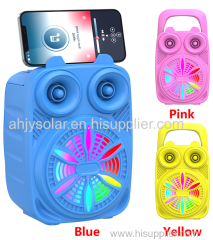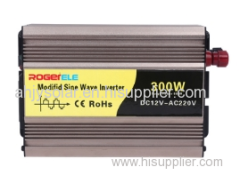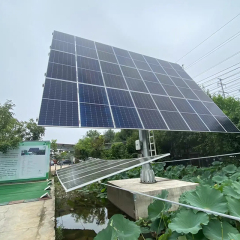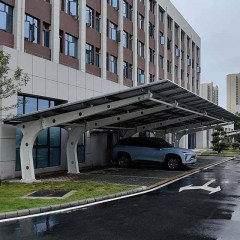|
Hebei Jinbiao Construction Materials Tech Corp., Ltd.
|
Support structure of dual-axis solar tracker
| Price: | 3571.0 USD |
| Payment Terms: | T/T |
| Place of Origin: | Hebei, China (Mainland) |
|
|
|
| Add to My Favorites | |
| HiSupplier Escrow |
Product Detail
The support structure of the dual-axis solar tracker is a highly integrated electromechanical system. By precisely coordinating the four major subsyst
The support structure of the dual-axis solar tracker is a highly integrated electromechanical system. By precisely coordinating the four major subsystems of mechanics, drive, control and assistance, it realizes the dual-dimensional tracking of photovoltaic modules at the azimuth Angle (horizontal rotation) and elevation Angle (pitch adjustment). Its design needs to strike a balance among rigidity, lightweight, environmental adaptability and operation and maintenance efficiency. The following is a comprehensive elaboration of each component and their synergistic effects from a system perspective:

1. Mechanical structure: The skeleton and joints of the system
The core of the supporting structure of the dual-axis solar tracker is the main frame and the moving joints.
The central column serves as the load-bearing main body, typically made of hot-dip galvanized steel pipes with a diameter of 200 to 400mm. The foundation depth needs to be customized according to geological conditions (usually ≥1.5m) to ensure that the inclination is less than 1° under extreme wind loads (such as 25m/s).
The azimuth turntable adopts slewing bearing with internal gear ring (such as INA YRT series), and the static load-bearing capacity needs to reach more than five times the total weight of the component to resist the dynamic wind torque.
The pitch boom is mostly made of aluminum alloy truss structure, and the torsional stiffness is achieved to be greater than 100Nm/° through finite element optimization. At the same time, it integrates component installation rails (anodized aluminum profiles), which are compatible with the rapid installation of mainstream photovoltaic panels.
In the motion joint, the azimuth Angle bearing selects four-point contact ball bearing (clearance ≤0.05mm), while the pitch shaft hinge adopts a combination of self-lubricating copper sleeve and stainless steel shaft to ensure that the annual wear is less than 0.01mm in salt spray environment.
2. Drive system: Precise movement of muscles and nerves
The dual-axis drive of the support structure of the dual-axis solar tracker needs to match the mechanical requirements in different dimensions:
Azimuth drive is typically equipped with a brushless DC motor (such as 48V/500W) paired with a planetary gearbox (reduction ratio 1:100), and integrates a 17-bit absolute encoder to achieve a positioning accuracy of ±0.2°. The motor torque should cover the sum of the wind load torque (such as approximately 120Nm at a wind speed of 30m/s) and the friction torque (approximately 50Nm).
Pitch drive mostly adopts electric push rods with IP68 protection grade (thrust 8kN, stroke 600mm) or ball screws (C5 precision grade), and the resolution is improved through harmonic reducers (reduction ratio 1:50). Transmission components such as polyurethane synchronous belts (Gates PowerGrip GT3) need to have UV resistance, and the preload can be adjusted by ±5% to compensate for long-term stretching.
3. Control System: Brain and Sensory Network
The core of the control system of the support structure of the dual-axis solar tracker is multi-sensor fusion and adaptive algorithm:
The industrial PLC (such as Siemens S7-1200) or the embedded controller (STM32H7) is used as the main control to receive real-time data from the dual-axis MEMS tilt sensor (±0.1° accuracy), the light intensity sensor array (cloudy differential mode), and the ultrasonic anemometer (15m/s trigger threshold).
The GPS module (such as u-blox NEO-M8N) provides latitude and longitude as well as UTC time, supports astronomical algorithms in calculating the position of the sun, and combines PID closed-loop control to eliminate mechanical hysteresis. During continuous cloudy weather, the system automatically switches to the light intensity differential mode or enters the low-power sleep state (light intensity < 200W/m²).
4. Auxiliary System: Guardian of reliability
The support structure of the dual-axis solar tracker provides multiple guarantees for the auxiliary system to cope with complex environments:
The lightning protection device discharges the lightning current through grounding with a copper strip (resistance < 4Ω) and a lightning rod (1m higher than the component).
Cable management adopts drag chains (Igus E2.1 series) to protect the wire harnesses, with a bending radius of ≥10 times the wire diameter to avoid long-term bending damage.
In desert areas, positive pressure ventilation filters should be installed on the motors, and the steel components should be hot-dip aluminized (with better sand resistance than galvanized ones). In high-altitude and cold areas, self-regulating electric heating tapes (40W/m) are configured to automatically melt snow when the snow depth exceeds 5cm.
The lubrication system automatically maintains the rotating joints every six months through a centralized oil injection pipeline (lithium-based grease), reducing manual intervention.
5. Technological evolution and scenario adaptation
Cutting-edge technologies are driving structural innovation:
The carbon fiber main beam can reduce weight by 60%, but the cost issue needs to be addressed (target < $50/kg).
The magnetic levitation joint is in the laboratory stage and is expected to achieve zero-wear transmission.
Digital twins predict the lifespan of components through strain gauges and vibration sensors, reducing the risk of sudden failures.
Selection case: In the 50MW desert power station in the Middle East, the SKF 240/500 CAK30/C3 bearing (resistant to 150℃ high-temperature grease) combined with the sand and dust filtering motor, along with the hot-dip aluminized steel structure, can meet the demands of extreme environments.
Summary
The support structure of the dual-axis solar tracker is an interdisciplinary achievement of mechanical design, materials science and automatic control technology. In the future, LCOE (Levelized Cost of Electricity per Kilowatt-hour) will be further reduced through modular joints (pre-integration of motor + bearing + encoder), self-powered drive (photovoltaic + supercapacitor), and intelligent operation and maintenance (AI fault prediction). If it is necessary to deepen specific links (such as ANSYS wind load simulation or torque calculation table), iterative optimization should be carried out in combination with specific site parameters.




